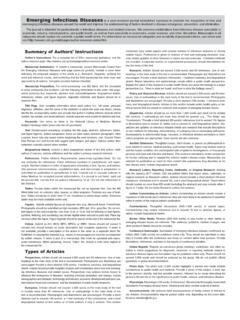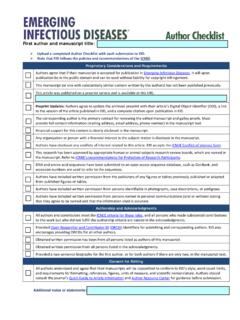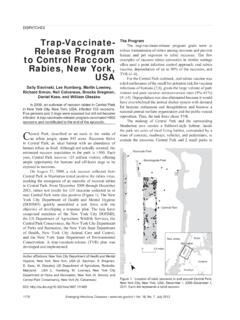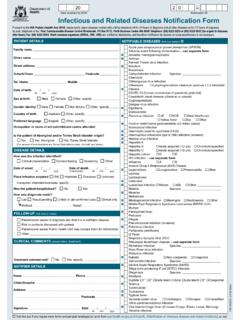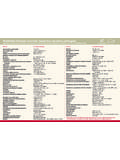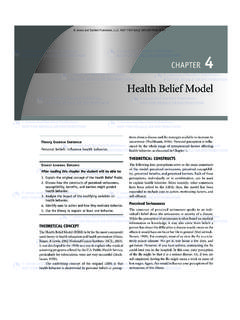Transcription of Chronic Wasting Disease and Potential Transmission to …
1 Chronic Wasting Disease (CWD) of deer and elk isendemic in a tri-corner area of Colorado, Wyoming, andNebraska, and new foci of CWD have been detected inother parts of the United States. Although detection in someareas may be related to increased surveillance, introduc-tion of CWD due to translocation or natural migration of ani-mals may account for some new foci of spread of CWD has raised concerns about thepotential for increasing human exposure to the CWD foodborne Transmission of bovine spongiformencephalopathy to humans indicates that the species bar-rier may not completely protect humans from animal priondiseases. Conversion of human prion protein by CWD-associated prions has been demonstrated in an in vitro cell-free experiment, but limited investigations have notidentified strong evidence for CWD Transmission tohumans. More epidemiologic and laboratory studies areneeded to monitor the possibility of such Wasting Disease (CWD) is classified as a trans-missible spongiform encephalopathy (TSE), or priondisease, along with other animal diseases, such as scrapieand bovine spongiform encephalopathy.
2 The only knownnatural hosts for CWD are deer (Odocoileusspecies) andRocky Mountain elk (Cervus elaphus nelsoni) (1,2). CWDand other TSEs are believed to be caused by a pathogeniceffect on neurons of an abnormal isoform of a host-encod-ed glycoprotein, the prion protein. The pathogenic form ofthis protein appears to be devoid of nucleic acids and sup-ports its own amplification in the host. TSEs in animalsprimarily occur by transmitting the etiologic agent withina species, either naturally or through domestic husbandrypractices. In contrast, most such encephalopathies inhumans occur as a sporadic Disease with no identifiablesource of infection or as a familial Disease linked withmutations of the prion protein gene (3). A notable excep-tion among the human TSEs is the variant form ofCreutzfeldt- jakob Disease (vCJD), which is believed tohave resulted from the foodborne Transmission of bovinespongiform encephalopathy (BSE) to humans (4,5).
3 CWD was first identified as a fatal Wasting syndromeof captive mule deer in the late 1960s in research facilitiesin Colorado and was recognized as a TSE in 1978 (6,7).Subsequently, this Wasting Disease was identified in muledeer in a research facility in Wyoming and in captive elkin both the Colorado and Wyoming facilities (6 8). Thedisease was first recognized in the wild in 1981, when itwas diagnosed in a free-ranging elk in Colorado (1,9). Bythe mid-1990s, CWD had been diagnosed among free-ranging deer and elk in a contiguous area in northeasternColorado and southeastern Wyoming, where subsequentsurveillance studies confirmed it to be endemic (10).Epidemic modeling suggested that this Wasting diseasemight have been present among free-ranging animals insome portions of the Disease -endemic area severaldecades before it was initially recognized (10). On thebasis of hunter-harvested animal surveillance, the overallprevalence of the Disease in this area from 1996 through1999 was estimated at approximately 5% in mule deer,2% in white-tailed deer, and <1% in elk (10).
4 In 2000, sur-veillance data indicated that the Disease -endemic focusextended eastward into adjacent areas of Nebraska (1,11),and ongoing surveillance continues to redefine the limitsof this manifestations of CWD include weight lossover weeks or months, behavioral changes, excessive sali-vation, difficulty swallowing, polydipsia, and polyuria(1,6 8). In some animals, ataxia and head tremors mayoccur. Most animals with the Disease die within severalmonths of illness onset, sometimes from aspiration pneu-monia. In rare cases, illness may last for >1 year. In cap-tive cervids, most cases occur in animals 2 7 years of age;however, the Disease has been reported in cervids as youngas 17 months and as old as >15 years of age (1). This dis-ease can be highly transmissible within captive deer andelk populations. A prevalence of >90% was reportedamong mule deer in facilities where the Disease has beenendemic for >2 years (2,6,7,12).
5 The mode of transmissionamong deer and elk is not fully understood; however, Chronic Wasting Disease andPotential Transmission to HumansErmias D. Belay,* Ryan A. Maddox,* Elizabeth S. Williams, Michael W. Miller, Pierluigi Gambetti, and Lawrence B. Schonberger*Emerging Infectious Diseases Vol. 10, No. 6, June 2004977*Centers for Disease Control and Prevention, Atlanta, Georgia,USA; University of Wyoming, Laramie, Wyoming, USA; Colorado Division of Wildlife, Fort Collins, Colorado, USA; and Case Western Reserve University, Cleveland, Ohio, USAevidence supports lateral Transmission through direct ani-mal-to-animal contact or as a result of indirect exposure tothe causative agent in the environment, including contam-inated feed and water sources (12).Geographic Distribution of Chronic Wasting DiseaseThe geographic extent of CWD has changed dramati-cally since 1996 (2). Two largely independent and simulta-neous epidemics, one in free-ranging deer and elk andanother in the captive elk and deer industry, appear to rep-resent the main framework for explaining the Disease scurrent distribution (2).
6 More extensive and coordinatedsurveillance has provided a clearer picture of its distribu-tion over the last few years. Since 2000, the Disease in free-ranging cervids has been increasingly identified outside ofthe original CWD-endemic areas of Colorado andWyoming (Figure). The observed distribution seems to berelated in part to natural movement of deer and elk and tocommercial movement of infected animals to areas farfrom the Disease -endemic zone. Considerable attention hasbeen given to recent increases in the geographic spread ofthe Disease , which in some areas is likely a result ofincreased surveillance rather than evidence of explosivegeographic single original event or source links all Wasting dis-ease foci documented to date. Given the Disease s insidiousnature and the apparent duration (at least several decades)of epidemics among captive and free-ranging cervids, gapsin knowledge about its spread and distribution are not sur-prising, particularly within the captive deer and elk indus-try.
7 However, our current knowledge cannot explain someof the distinct foci of CWD among free-ranging animals( , in New Mexico and Utah). Thus, unidentified riskfactors may be contributing to the occurrence of CWDamong free-ranging and captive cervid populations insome Wasting Disease in Free-ranging Deer and Elk In 2000, surveillance of hunter-harvested deer firstdetected the occurrence of CWD in counties in southwest-ern Nebraska, adjacent to the previously recognized areasof Colorado and Wyoming that are endemic for this dis-ease (Figure) (1,11). It was reported subsequently in otherNebraska counties, including among deer and elk in acommercial, large enclosure surrounded by a fence innorthwestern Nebraska, where the prevalence of CWDwas >50% (11). Free-ranging deer from areas surroundingthe enclosure also tested positive for the Disease but at sub-stantially lower rates. In 2001, CWD in a free-ranging deerwas identified in the southwestern part of South Dakotaalong the Nebraska border close to an area where the dis-ease had been reported among captive elk (13).
8 Since then,additional CWD-positive free-ranging deer and elk havebeen identified in southwestern South Dakota. CWD in free-ranging cervids was first reported east ofthe Mississippi River in Wisconsin among white-taileddeer harvested in the 2001 hunting season (14).Subsequent surveillance indicated that this CWD epidem-ic focus was limited to several counties in the south-centralregion of Wisconsin, although a second focus spanning theIllinois border was also detected (15). The absence of evi-dence for a widespread occurrence of CWD and its lowprevalence, despite a highly dense deer population, indi-cate that the Disease probably was recently introduced intoWisconsin. Because the distance from the CWD-endemicarea of Colorado-Wyoming effectively precludes eastwardmigration of animals as a logical source of infection, CWDin Wisconsin was more likely introduced by an importedinfected cervid or some other unidentified source (14).
9 Theproximity of the Wisconsin-Illinois focus to a white-taileddeer farm with infected animals appears to support thisexplanation, as highlighted by the report of CWD in a pre-viously captive white-tailed deer approximately 7 monthsafter it escaped into the wild in southern Wisconsin (14).The Disease among the captive deer herd from which thewhite-tailed deer escaped was demonstrated earlier, whena still-captive deer tested positive for the Disease . The cap-tive source herd was held in a facility 30 50 km from theIllinois location where CWD was recently identified in afree-ranging deer (16). In 2002, the Wisconsin Departmentof Natural Resources launched an ambitious culling pro-gram by providing special hunting permits to eliminate thedisease in a designated eradication zone around the areaswhere it was detected (15,17). Whether such aggressivemanagement will succeed in eliminating free-ranging fociof CWD remains to be Colorado, the Continental Divide initially appearedto have prevented natural expansion of CWD into the978 Emerging Infectious Diseases Vol.
10 10, No. 6, June 2004 PERSPECTIVESF igure. Chronic Wasting Disease among free-ranging deer and elkby county, United part of the state. However, in 2002, the diseasewas confirmed for the first time in several free-rangingdeer harvested in western Colorado in an area surroundinga commercial enclosure, where entrapped mule deer test-ed positive for CWD. Aggressive culling of deer and elksurrounding the enclosure was initiated to prevent furtherspread of the Disease in the western slope of the 2002 hunting season, CWD-positive deer andelk continued to be identified outside of the previouslydefined Disease -endemic area, primarily in northwesternColorado (18). This northwestern focus appears to be dis-continuous from the previously identified CWD-endemicarea, although surveys conducted in 2002 demonstratedthat the western and southern boundaries of that area werewider than previously believed. The ultimate source ofthis Wasting Disease in northwestern Colorado 2002, samples from an emaciated, free-ranging muledeer found in White Sands, New Mexico, tested positivefor CWD (1,19).
